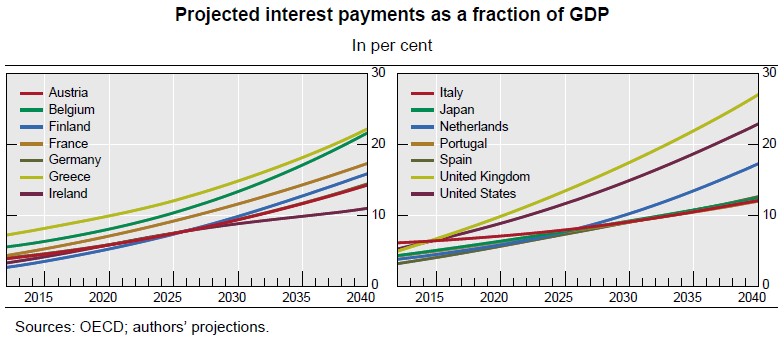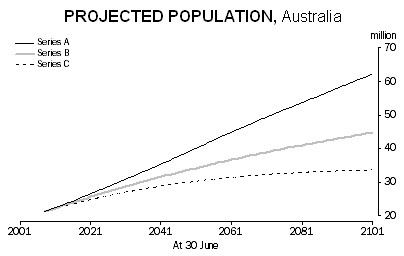
The ageing of the large baby boomer generation is viewed as a huge problem for government finances in the developed world.
A working paper released last year by the Bank for International Settlements (BIS) forecast large and rising future costs relating to the ageing of their populations unless drastic measures are taken to curb the rapid growth of health care and pension obligations (see below chart).
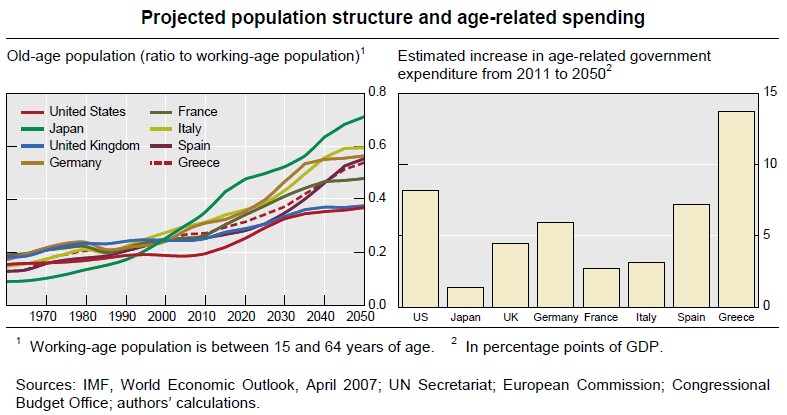
The rising age-related costs on diminishing tax bases (since a lower proportion of the population will be in paid employment) are projected by the BIS to significantly increase developed country budget deficits and interest burdens (see below chart).
It’s a similar story in Australia. According to the 2010 Intergenerational Report (IGR):
Population ageing will create pressure for increased spending, particularly in the demographically sensitive areas of age related programs and health. Health costs will also escalate as a result of technological enhancements and rising demand for better quality health services. Population ageing, by reducing the proportion of working age people in the population and hence potential economic growth rates, will also reduce Australia’s capacity to fund these spending pressures.
Unless action is taken to increase the growth potential of the economy and ensure spending is sustainable, spending will exceed revenue and result in a fiscal gap of 2¾ per cent of GDP by 2049–50.
One popular solution to Australia’s ageing ‘problem’, as advocated by population commentator Bernard Salt is to increase the number of taxpayers via immigration. According to Mr Salt, such a strategy would enable Australia to pay for the retirement needs of the Baby Boomers. It would also support consumption spending, the construction industry and asset values.
I have always considered Mr Salt’s arguments problematic. Continually boosting immigration and/or birth rates only delays the ageing problem, since these extra people will also grow old and require support in their elderly years either through increased social security expenditure or, more importantly, age-related health care spending [of course entitlements could be reduced to mitigate these impacts].
Interestingly, data extracted from the Australian Bureau of Statistics (ABS) long-term population projections does not support Mr Salt’s contention that Australia’s ageing-related problems can be mitigated via population growth.
As mentioned previously (here and here), the ABS’ projections provides detailed estimates of Australia’s population under three scenarios:
- High growth scenario (Series A), which assumes an increase in the fertility rate, higher net overseas migration than existed in 2008, and an increase in life expectancy;
- Medium growth scenario (Series B), which largely reflected the trends in fertility, life expectancy at birth, and net overseas migration that existed in 2008; and
- Low growth scenario (Series C), which assumes low assumptions for fertility and net overseas migration.
The assumptions underpinning these projections are once again provided in the table below:
And the projected trajectory of Australia’s population under these assumptions is shown below:
Below I have extracted the ABS’ data under the three scenarios into Dependency Ratios – defined as the ratio of the non-working population, both children (<15 years old) and the elderly (over 65 years old), to the working age population.
First, consider Australia’s dependency ratios under the low growth scenario (Series C):
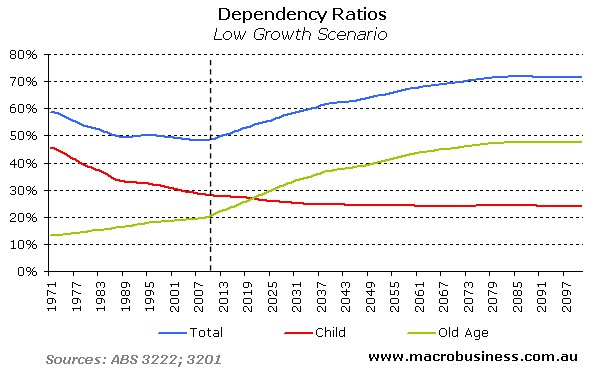
As you can see, Australia’s total dependency ratio is projected to increase sharply, from around 50% currently to just over 70% by the end of the century. This increase in the dependency ratio is driven by a steady increase in the proportion of the population aged over 65 (the standard ‘retirement age’), offset partly by a reduction in the child dependency ratio (i.e. those aged under 15 years of age).
Now consider the projected dependency ratios under the medium growth scenario (Series B):
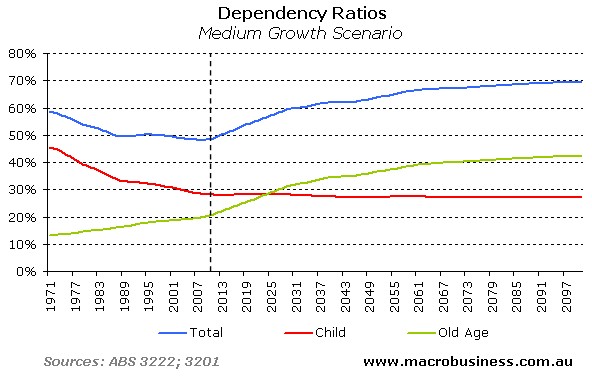
As you can see, there is minimal difference under this scenario, with the total dependency ratio increasing to just under 70% by 2100. Although the old age dependency ratio is reduced under Series B, the gains are nearly fully offset by an increase in the child dependency ratio.
Finally, consider Australia’s projected dependency ratio under the high growth scenario (Series A):
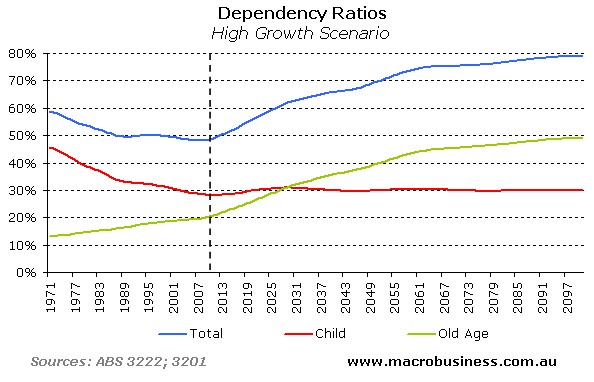
Amazingly, the high growth scenario provides the worst outcome, with Australia’s total dependency ratio projected to increase to nearly 80% by the end of the century. Although the old age dependency ratio is much the same as under the low growth scenario, the proportion of younger people is significantly higher.
Hence, based on the ABS’ projections, the calls for Australia to increase its immigration and/or birth rates in order to mitigate the impacts of an ageing population appear to be misguided. And this view was recently supported by the Productivity Commission in its submission to the Minister for Population:
…several studies, including some undertaken by the Commission, indicate that policy-induced changes to Australia’s population are unlikely to significantly affect the ageing trends.
Improvements in longevity are the major cause of population ageing over the long run. In recent projections, Commission researchers estimated that an increase in the long-run total fertility rate from 1.85 to 2.10 births per woman — even if it could be achieved — would be associated with only a 1.1 percentage point reduction in the proportion of people aged over 65 by 2051.
Similarly, substantial increases in the level of net overseas migration would have only modest effects on population ageing and the impacts would be temporary, since immigrants themselves age. The Commission has estimated that an increase in annual net migration from 150 000 to 300 000 would lower the proportion of those aged 65 or over by less than 3 percentage points by 2044-45. As an illustration ofthe challenge, the Commission showed that delaying an increase in the dependency ratio by 40 years would require a net migration-to-population ratio of 3 per cent per year, leading to a population of around 85 million by 2044-45.
It follows that, rather than seeking to mitigate the ageing of the population, policy should seek to influence the potential economic and other impacts.
Food for thought.
Cheers Leith

